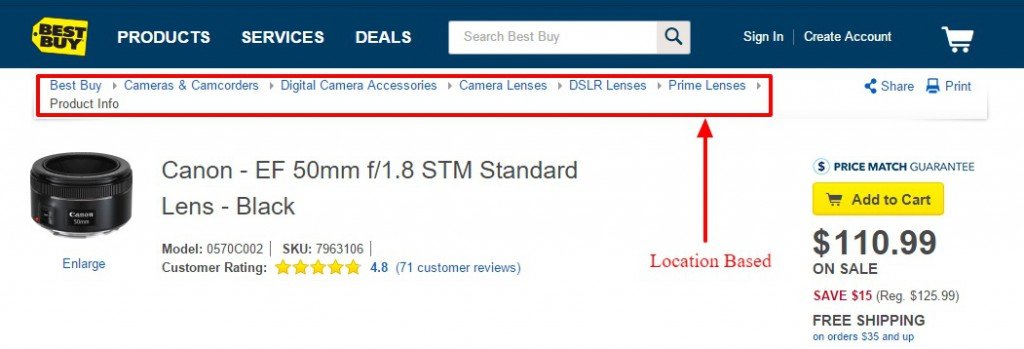While their breadcrumbs trail didn’t work out so well in Hansel and Gretel, they work exceedingly well in helping visitors and search engine bots from getting lost while wading through your website.
Not only do they make your website more accessible in Google search results, but they also have some implications to your SEO that may prove beneficial enough to take the small amount of time required to implement breadcrumbs.
Let’s explore the different types of breadcrumbs, how you might use them and their various implications in terms of how they might prove beneficial to your SEO efforts.
Table of Contents
What Are Breadcrumbs?

Breadcrumbs allow a user to retrace their steps from your home page to the web page that they’re currently viewing.
A breadcrumb trail can reflect the structure of your website, a logical path or attributes of the current page.
When used properly, they can add context to your innermost web pages while reducing many of the factors that might negatively affect your site’s SEO, such as your bounce rate.
The Types of Breadcrumbs
While there are many variations of breadcrumbs and breadcrumb schema markup, they generally fall into one of the three following types:
1. Location Breadcrumbs – These are breadcrumbs that trace back through the different layers of your website. Following one of these breadcrumbs will allow users to visit a page that plays host to similar pages in the same category.An example of hierarchy based breadcrumbs would be: Home > Law > Finances > Bankruptcy Information.
2. Path Breadcrumbs – This type of breadcrumb trail represents the various logical paths that a user could use to reach a page.
That means multiple breadcrumbs can lead to the same page.
3. Attribute or Keyword Breadcrumbs – Breadcrumbs of this nature follow a similar path as described by location breadcrumbs.
The difference is that instead of using something like the page title or another unique identifier, keywords and attributes that describe the page are used.
Technical support pages and e-commerce websites are two of the more common places where this breadcrumb is used.
The last two types of SEO breadcrumbs can result in duplicate breadcrumbs, which may have a negative impact on how search engines interpret your website’s SEO attempts.
If this is the case, then opt for location-based breadcrumbs.
The Advantages of Breadcrumbs for Users
Breadcrumbs are an essential part of helping users understand how your website works.
They encourage positive actions, such as delving deeper into your website to look for other pages that will likely interest them in some way.
When users undergo such positive actions, they reduce the negative factors like your website’s bounce rate.
This helps your pages rank higher in SERPs.
Below is a brief list of all the things that breadcrumbs can do for you website’s users:
- They help users understand the layout of your website. This makes breadcrumb navigation links one level higher to find similar content while staying on your website.
- They’re completely optional. They won’t overwhelm users that don’t want to use them, nor will they detract from your page due to their compact nature.
- They allow users to scan through your website and to view more content at a faster rate.
- They’re easy to implement and can be understood regardless of a user’s education, professional background or technical knowledge.
The Advantages of Breadcrumbs for SEO
Despite their numerous benefits for visitors, attribute based breadcrumbs have a number of advantages when it comes to search engines.
Breadcrumb structured data can pass on context to the inner and outer pages of your website in a natural and logical way that search engines love.
Here’s a brief list of what breadcrumbs can do to improve your SEO:
- They can point keywords to certain pages while helping search engines to see how one page relates to another on your website. When used in a hierarchy, this improves SEO done to both your category pages and your innermost pages.
- They reinforce and improve your website’s internal linking site structure. Pairing breadcrumbs with contextual linking to other related pages will result in larger gains when off-site SEO is applied.
- Schemas can be used to describe them. This allows Google and other advanced search engines to understand that what their robots are looking at is a breadcrumb, which in turn allows for additional functionality like the display of breadcrumbs in SERPs to become available. This can facilitate more users browsing your website’s inner pages.
Optimizing Breadcrumbs for SEO
Optimizing your breadcrumbs for SEO is a tedious balancing act.
Too much optimization can result in over-optimization penalties, but there is no real penalty for “under-optimizing” so long as your breadcrumb structure remains intelligent.
When optimizing for keywords, you should follow a structure similar to the one below:
A link to your home page using your website’s main keyword > Your main keyword followed by a category keyword > Your main keyword with a keyword that describes the page the user is on
As discussed earlier, it may be advantageous to omit certain parts to avoid over-optimizing.
For example, it’s fine to just leave the category part as a single keyword or phrase that describes the category.
Additional Tips for Usable Breadcrumbs
Not all breadcrumbs are created equally, nor do they all perform as well.
Below is a small list of tips that will help you ensure your breadcrumbs are friendly towards both users and search engines.
- If you add breadcrumbs with the right schema markup, then you can use almost any kind of styling when it comes to your breadcrumbs. It may be advantageous to style your breadcrumbs in a way that makes them appealing for visitors to use. If you can, use a plugin like Yoast SEO to quickly incorporate breadcrumbs schema markup.
- Don’t rely solely on your breadcrumbs. As Hansel and Gretel would likely say, relying on just breadcrumbs is a dangerous and fool-hardy move. Don’t replace the vital parts of your website like your navigation and internal linking with breadcrumbs, but do use breadcrumbs as an addition to make navigating your website better.
- Breadcrumbs describe a hierarchy, which means that they shouldn’t be used if your website currently has all your pages listed under one or two categories.
- Don’t use your breadcrumbs to replace the “back” button of a user’s browser. Breadcrumbs should facilitate moving forward to closely-related pages contained one or more levels up in a category.
- Breadcrumbs need to be located in an accessible and somewhat prominent spot to be effective. The top-left corner of your website’s layout or below your page’s largest header will usually make for a good place to place your breadcrumbs. This allows users to know that they’re there and allows for search engine spiders to recognize that your breadcrumbs are valuable.
The Bottom Line Concerning Breadcrumbs
Breadcrumbs are a useful navigational feature that encourages users to browse more of your site. This is especially important if your website has a complex hierarchy that may dissuade users from delving deeper into it, even if the first page they land on from a search engine is one that they like.
Breadcrumbs also give search engines clues about the structure of your website and make your overall SEO efforts more effective.
Furthermore, implementing SEO breadcrumbs should be easy if your pages have a dynamic delivery system in place.
With all the benefits to the usability of your website that they bring, there’s no reason that you shouldn’t use them.
Tim holds expertise in building and scaling sales operations, helping companies increase revenue efficiency and drive growth from websites and sales teams.
When he's not working, Tim enjoys playing a few rounds of disc golf, running, and spending time with his wife and family on the beach...preferably in Hawaii.
Over the years he's written for publications like Forbes, Entrepreneur, Marketing Land, Search Engine Journal, ReadWrite and other highly respected online publications. Connect with Tim on Linkedin & Twitter.
- How to Become an SEO Expert in 2026 - December 15, 2025
- Best Link Building Strategies for SEO in 2026 - December 8, 2025
- Content Length: What’s the Ideal Length of a Blog Post for SEO in 2026? - December 3, 2025

